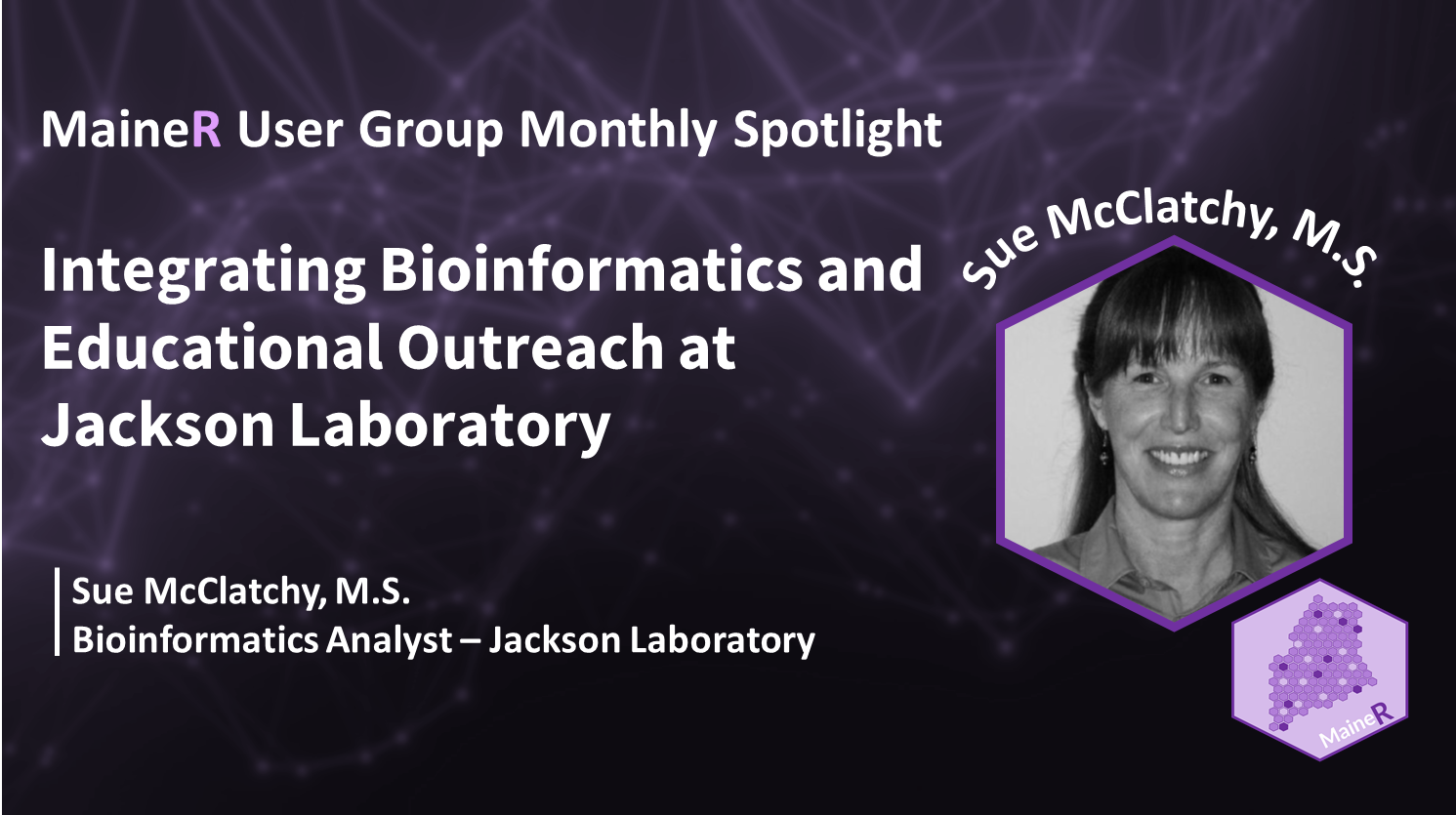
Introduction:
I’m Sue McClatchy, a bioinformatics analyst at Jackson Laboratory. I moved to Maine 20 years ago to join the lab after finding a job posting that seemed perfectly tailored for me—it required a computational biologist with teaching expertise, which fit my background precisely. Over the years, I’ve engaged in statistical genetics and teaching, working closely with Gary Churchill, who is also my manager. My work and the stimulating intellectual environment at Jackson Lab, combined with the incredible natural surroundings of Maine, have made this a fulfilling place to thrive professionally and personally.
1. Discovering R - My Initial Spark:
What got you interested in R?
My interest in R began when I started working in statistical genetics here at Jackson Lab. I was immediately impressed by the powerful graphics and the ability to produce detailed reports, which significantly enhanced the communication of our scientific findings. Particularly, tools like ggplot and the tidyverse package opened up new ways for us to visualize complex data clearly and effectively. This capability was transformative for my work, prompting me to start teaching R to high school students. I was impressed by how quickly these high school students could grasp statistical genetics or R, even conducting their own computational research projects and presenting their findings at scientific competitions.
2. R in Practice: Leveraging Statistical Computing to Drive Healthcare Research
Do you use R at work? How?
Yes, I use R extensively at work, primarily for quantitative trait locus (QTL) analysis, which helps identify the genomic locations associated with specific traits like cholesterol levels, blood pressure, or blood sugar. This type of analysis is crucial for understanding the genetic foundations of these traits, aiding in the identification of genes that influence them, and suggesting further experiments. R’s robust statistical tools allow us to pinpoint these genetic influences accurately.
Additionally, I use R in teaching and lesson development. It’s not just a tool for professional researchers; I also incorporate it into educational programs, teaching high school students and others how to apply R in real-world genetic research. This dual use of R—for both cutting-edge research and education—highlights its flexibility and power in various aspects of scientific inquiry and learning.
3. Beyond Programming
What do you do when you’re not programming?
When I’m not programming, I try to disconnect from work and engage with the outdoors as much as possible. Living next to Acadia National Park offers a magnificent escape into nature, which I find both refreshing and inspiring. Recently, I’ve embraced the challenge of finding joy in the rain—turning what could be gloomy weather into an opportunity for adventure. This mindset shift has led me to volunteer with projects like the Acadia Amphibian Project and Maine Big Night, where I help monitor and safely assist amphibians crossroads during their critical migration periods.
4. Anticipating Trends
What trends do you see in R language over the next year?
Over the next year, I expect to see continued innovation in the R language, particularly in its capabilities for graphics and data modeling. Tools like ggplot are likely to become even more powerful and user-friendly, enhancing their utility in scientific visualization.
5. Community and Coding
What is your favorite R event that you have attended?
My favorite R-related event was a Data Carpentry workshop that I led with Angie Reed from the Penobscot Nation. This wasn’t just any workshop; it was specifically designed to empower tribal professionals from across the Northeast. We focused on teaching them how to organize their data and use R to enhance their work in monitoring and protecting natural resources. I taught this course alongside Julia Brown from the Bigelow Lab in Boothbay, which made the experience even more enriching.
This event was particularly meaningful because it aligned with my personal values of making a positive impact through education and conservation. Providing these crucial skills to tribal professionals, who play a key role in preserving their communities’ natural resources, was immensely fulfilling. It demonstrated how R can be a powerful tool for social change and community empowerment, making it my favorite event for its impact and the meaningful connections it fostered.
6. Future Endeavors
What projects (R-focused or otherwise) are you excited about in the coming year?
In the coming year, I’m particularly excited about a potential project that involves teaching R and bioinformatics to Native students in New Mexico, alongside providing them with industry internships. This project, if funded, would not only enhance their career opportunities but also enable them to give back to their tribes by sharing their newfound skills. It’s a wonderful intersection of education, empowerment, and community service, all facilitated through the power of R.
Additionally, I am involved in writing grants to secure funding for these initiatives. The success of these applications would allow me to continue doing work that is deeply meaningful to me—using my skills in R to effect real change in communities and help address broader issues like education accessibility and environmental conservation. This blend of R’s technical capabilities with its potential for social impact is what I find most thrilling about the projects lined up for the next year.